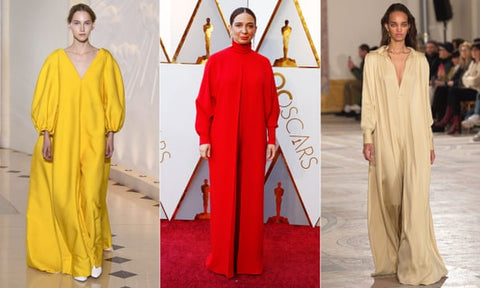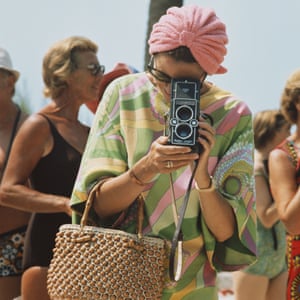Kaftan cool: why covering up is the new skimpy dressing this summer
Forget the slogan T-shirt – the kaftan is the new political fashion statement to make
by Jess Cartner-Morley for The Guardian

Maya Rudolph in a Valentino kaftan at the Oscars (centre). Kaftans by Emilia Wickstead (left) and Simon Porte Jacquemus (right). Composite: Getty Images
So I’ve got a party coming up, the kind that requires a proper look. A party where people who look really good at parties will bring their A-game. A party that has already provoked an advance period of what-are-we-wearing discussion with other guests. The sort of party, in other words, that is a full-blown wardrobe crisis waiting to happen.
Except not this time, because I know exactly what I want to wear. I know the look that will feel zeitgeist but not fashion victim, glamorous but not self-conscious. What’s more, it is super comfortable, I don’t have to wear heels with it and it requires zero beach-body-ready nonsense, because there is no waistband to do up. And it covers most of my body, so I won’t even have to sheep-dip myself in St Tropez like I normally do when I go out.

Princess Grace of Monaco wearing a Pucci kaftan in 1972. Photograph: Hulton Archive/Getty Images
I am going to wear a kaftan, obviously. My longtime favourite is a Maje one, silvery and tissue-thin, with wide flowing sleeves and a hemline almost to the floor, but I am seriously considering investing in a gold-edged one covered in leopards and tiger lilies by the London-based label Lazul. The kaftan – a unisex garment with a storied global heritage, which refuses to peg fabulousness to any particular dress size – feels right for now in a way that no skimpy, wiggle-into-it number does. A woman wearing a kaftan takes up physical space, rather than whittling herself down to the capacity of a pair of Spanx. She is comfortable, she can dance, she brings with her a bit of 1966-era mood music. The red-carpet blackouts of the Golden Globes and the Baftas set the tone for a year in which glamour is politicised. Wearing a trad party dress feels a bit basic, tbh. If last summer’s style slogan was The Future Is Female, as seen on a trillion T-shirts, the message of 2018 is that The Woke Wear Kaftans.
I should admit here that I am biased. I have written before about my longstanding love affair with the kaftan, a hot-weather garment steeped in history, with roots in what was then Mesopotamia. But this summer it’s not just me. In the May issue of British Vogue, model Karly Loyce wears Emilia Wickstead’s kaftan-shaped, balloon-sleeved Octavia gown. (Fashion director Venetia Scott made a yellow turban to go with it.) At the most recent Paris fashion week, the hit show by the fashion editors’ favourite designer, Simon Porte Jacquemus, opened with a buttermilk satin kaftan inspired by a trip to the recently opened Yves Saint Laurent museum in Marrakech. Maya Rudolph’s scarlet Valentino kaftan was a standout look of this year’s Oscars. On vintage sites, prices for trophy kaftans have risen sky-high. A Gina Fratini rainbow-sleeved kaftan, as worn by Liz Taylor at her (second) wedding to Richard Burton in 1975, now fetches more than £6,000.
This is all the more striking because until a couple of years ago the kaftan was frankly naff. The glory years of Saint Laurent in Marrakech were long gone and the kaftan had been hemmed to the upper thigh and adopted by bejewelled women with too-dark tans, dancing badly in beach bars to terrible music. How times change. This summer there are 60 super-chic kaftans to choose from at Net-a-Porter, and sales are up 25% on last year at Stylebop, where the cool linen kaftan-style maxis by Three Graces London, designed by Céline-wearing Irishwoman Catherine Johnson, are flying out, as are bell-sleeved pieces with rich Ukrainian embroidery by New York label March11. At Matches Fashion, Pippa Holt kaftans are bestsellers, says buyer Chelsea Power, “to be worn with jeans and slides now, and then thrown over a swimsuit on holiday”, while turbans by Norma Kamali, a Studio 54 regular and iconic New York designer for three decades, are proving a surprise hit of the season. Harvey Nichols has recently taken on three new kaftan-type brands: Sundress, Innika Choo and Lemlem, to add to Marios Schwab’s On The Island label.
Like an enormous pair of sunglasses, a kaftan has a double-edged look-at-me/don’t-look-at-me vibe. It is a cover-up, but it is definitely not for wallflowers. Diana Vreeland, who said of style that “without it, you are nobody”, was a fan, writing in Vogue that kaftans were “for the beautiful people”. Princess Grace wore Pucci kaftans with matching turbans and was photographed several times in the dramatic La Bayadère kaftan designed by Marc Bohan for Christian Dior in 1969.
The kaftan is laid-back, but it flirts with danger in its anything-goes vibe: Talitha Getty wears a multicoloured kaftan in the portrait by Patrick Lichfield, taken on the starlit terrace of the Marrakech palace where she entertained the Rolling Stones and Yves Saint Laurent, two years before she died of a heroin overdose.
“We would all go to work in a kaftan if it was up to me,” says my fellow enthusiast Nina Deckers, the founder of Lazul. But the kaftan’s appeal is bound up in that of days spent by a pool with a glass of rosé and has been boosted by the elevation of what we wear on holiday. A few years ago, to wear earrings on the beach would have been considered eccentric; now it is the norm. At Net-a-Porter, where the holiday wardrobe now has its own offshoot – Jet-a-Porter – global buying director Elizabeth von der Goltz reports that 60% of spending on beachwear is on kaftans and cover-ups rather than swimwear. And since we are spending more on what we pack in our suitcases, we are more inclined to give these pieces a run out at home. The poolside kaftan, reinvented as a languorous party dress, translates better to real life than the giant inflatable flamingo.
Stylebop’s Coco Chan describes the kaftan as “empowering”, while Deckers believes “there is a sexiness in a silk kaftan that can never be attempted by a tight-fitting dress. The playfulness of silk around a female body is something so gorgeous.” The body politics of the kaftan are complex. Is it more empowering to reject objectification by covering your body, or to signal ownership of your sexuality by celebrating it? Does dressing modestly make you complicit in a patriarchal notion that women’s bodies are shameful, or does it semaphore sisterhood by refusing to make party-dressing a body-competitive sport? Both points of view have their champions. But this summer, only one is winning the fashion argument.
This article was taken from The Kaftan Archives and was published in 2018.
